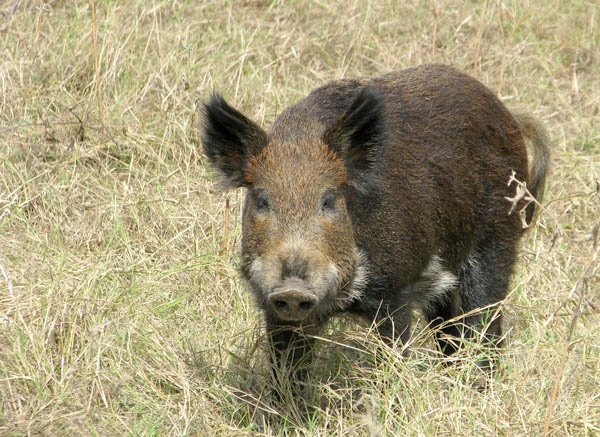January 4, 2012

Trapping wild pigs is a lot more complicated than setting a trap and waiting until a pig stumbles into it. Successful trapping requires reconnaissance, bait selection, attention to detail in building the trap — and, perhaps most important, patience.
“Traps are the No. 1 control method for landowners to remove wild pigs,” says Texas AgriLife Extension Wildlife Specialist Billy Higginbotham. “Unfortunately, most go about it in the wrong way.”
He explained some of the finer points of hog trapping during a presentation at the Ag Technology Conference at Commerce, Texas.
Building the trap correctly is important; he recommends they be at least 5 feet high and constructed of 4-inch wire mesh panels. “We need the small mesh to catch the smallest animals,” Higginbotham says.
He recommends a T-post every 4 to 5 feet. “Also, design the trap for easy load-out.” He recommends covering the corners, which otherwise may serve as ladders for pigs to escape.
“Also, remember that trapping wild pigs is a process, not an event.”
As with ground shooting, successful trapping requires preparation and a bit of patience.
“Set the trap as close to the pigs’ lay-up area as possible. Select a bait; the best is shelled corn—the gold standard.” Liquid berry flavors also entice hogs.
“A lot of baits are available, but don’t use the same one for every trap location,” Higginbotham says. “Pigs respond to different ones at different times of the year. Freshen the bait regularly with strawberry pop.”
Once hogs are on the bait, he recommends installing a wildlife camera to determine when the animals are coming to feed and how many are in the group. “For about $50, you can get a digital camera that’s waterproof and idiot-proof.” Camera images will indicate where to build the trap and how big to make it.
In areas with a lot of deer feeders, he says, landowners may have a more difficult time getting hogs on the bait. He recommends fencing deer feeders to keep hogs out. A 34-inch panel and a minimum of six panels should do the trick. But, a fence higher than 33 inches may also keep fawns out of the feeding area, so he recommends cutting some panels to 28 inches to improve fawn access.
Figure-8 trap
Researchers are also looking at a figure-8 trap for areas where multiple groups of pigs come in at different times of the night. Each oval of the figure-8 would have a separate baiting area and a separate trigger, so pigs coming in later would not be closed out of the trap.
Telemetry, placing collars on wild pigs, also may help improve trapping techniques. The collars follow pig movements and increase understanding of travel and feeding patterns.
Trappers have a market for live hogs, Higginbotham says. “We average selling 80,000 pigs to buyers every year. A big pig will bring 40 cents a pound.” Trapped pigs are slaughtered and inspected by the USDA.
No toxicants are currently permitted for hog control in Texas, but that may change, he says. “(Researchers) are evaluating sodium nitrate as a toxicant for wild pigs. The delivery system is the key.”
That key is a heavy hopper with a lid that hogs can lift with their snouts. “When the hogs back away, the lid slams shut,” denying access to non-target species. “Pre-baiting is necessary.”
Higginbotham says one potential sticking point is that raccoons may have access to the feeders.
“Pigs are very susceptible to sodium nitrate, but it is very humane. The pigs just go to sleep and don’t wake up. We see a good potential to get this registered by 2015. Every new tool we get will help.”
You May Also Like




